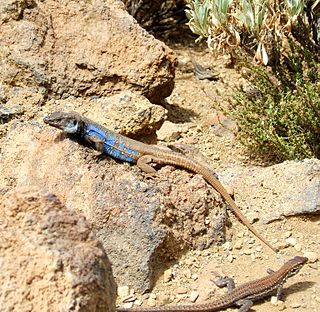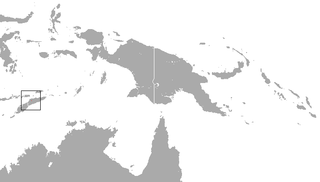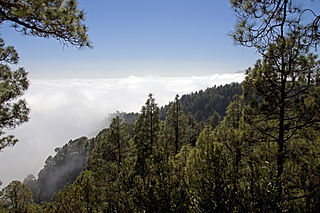
The Tenerife goldcrest, Regulus regulus teneriffae, is a very small passerine bird in the kinglet family, closely resembling the goldcrest but with a broader black band across the forehead, slightly darker underparts and a longer bill. It breeds in the Canary Islands of Tenerife and La Gomera, where it is a non-migratory resident. It prefers Canary Island Pine forests, but also occurs in laurisilva forests.

The brown long-eared bat or common long-eared bat is a small Eurasian insectivorous bat. It has distinctive ears, long and with a distinctive fold. It is extremely similar to the much rarer grey long-eared bat which was only validated as a distinct species in the 1960s. An adult brown long-eared bat has a body length of 4.5-4.8 cm, a tail of 4.1-4.6 cm, and a forearm length of 4-4.2 cm. The ears are 3.3-3.9 cm in length, and readily distinguish the long-eared bats from most other bat species. They are relatively slow flyers compared to other bat species.

The genus Plecotus consists of the long-eared bats. Many species in the genus have only been described and recognized in recent years.

Gallotia galloti is a species of lacertid in the genus Gallotia. The species is found on the Canary Islands of Tenerife and La Palma.

The western barbastelle, also known as the barbastelle or barbastelle bat, is a European bat in the genus Barbastella. This species is found from Portugal to Azerbaijan and from Sweden to Canary Islands, where a sub-species was identified. It has a short nose, small eyes and wide ears. The conservation status of B. barbastellus is assessed as "Near Threatened", "Vulnerable", "Critically Endangered" or "Extinct" in various parts of its range.

The grey long-eared bat is a fairly large European bat. It has distinctive ears, long and with a distinctive fold. It hunts above woodland, often by day, and mostly for moths. In captivity, it has also been recorded to eat small lizards. It is extremely similar to the more common brown long-eared bat, and was only distinguished in the 1960s, but has a paler belly.

The African blue tit is a species of bird in the family Paridae. It is found in northern Africa and the Canary Islands. Its natural habitat is temperate forests. This species and the Eurasian blue tit were formerly considered conspecific. The status of this species has not been assessed because it is noted to be common on the islands of Tenerife and Gran Canaria. The species has been used in many research studies due to its island populations and relevance to evolutionary hypotheses.
The Ethiopian big-eared bat or Ethiopian long-eared bat is a recently described species of long-eared bat in the family Vespertilionidae.

Rafinesque's big-eared bat, sometimes known as the southeastern big-eared bat, is a species of vesper bat native to the southeastern United States.

Nyctophilus arnhemensis, known as the northern or arnhem long-eared bat, is a species of Chiroptera (bats) native to northern regions of Australia. The distribution range is from north-western Queensland to northern Western Australia.

The small-toothed long-eared bat, species Nyctophilus microdon, is a vespertilionid bat. This flying mammal is found only in Papua New Guinea.

The big-eared roundleaf bat is a species of bat in the family Hipposideridae. It is endemic to Indonesia, known from Kangean Islands, southwestern Sulawesi and Seram Island. It roosts in caves and tree hollows and probably forages in woodland. It is threatened by habitat loss through logging and other human activities.
The big-eared mastiff bat is a species of bat in the family Molossidae endemic to Papua New Guinea, known from Gulf Province and Oro Province. It is only known from 11 specimens and it is not easy to survey. It forages in rainforest canopy and roosts in tree hollows. It is likely more widespread than currently known but additional research is needed.

The Sardinian long-eared bat is a species of bat endemic to Sardinia, Italy.
The Japanese long-eared bat is a species of vesper bat endemic to Japan, where it is found in Hokkaido, Honshu and Shikoku. It has distinctive, long ears, hence its Japanese name, the 'rabbit bat'. Formerly included as a subspecies of the European bat Plecotus auritus, genetic studies now indicate Plecotus sacrimontis is a separate species.

The Timorese horseshoe bat is a species of bat native to Timor-Leste.

Kolombatovic's long-eared bat, also known as the Mediterranean long-eared bat, is a European species of bat found in the Balkans.
Chilonatalus macer is a species of bat endemic to Cuba.
Plecotus gaisleri, also known as Gaisler's long-eared bat, is a species of bat in the genus Plecotus. It is medium-sized grayish-brown and found in Morocco, Algeria, Libya, and Tunisia.

The Canary Islands dry woodlands and forests is a Mediterranean forests, woodlands, and scrub ecoregion in the Canary Islands. It encompasses the western group of the Canary Islands – La Palma, El Hierro, La Gomera, Tenerife, and Gran Canaria – in the Atlantic Ocean. These volcanic islands are an autonomous community of Spain, and lie southwest of the Spanish mainland and west of the North African coast.
















